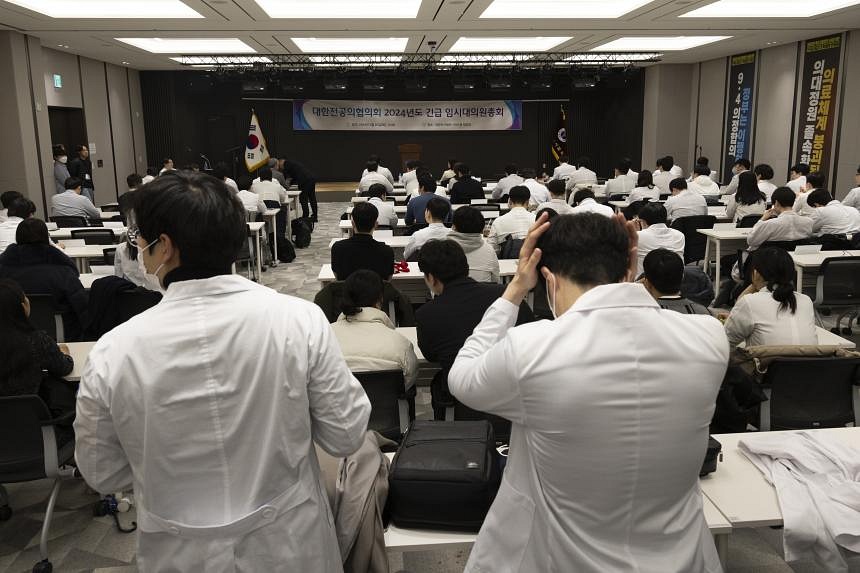SEOUL – More than 1,600 trainee doctors in South Korea walked out from their jobs on Feb 20, forcing hospitals to turn away patients and scramble to reschedule non-urgent medical procedures.
The collective action came a day after 6,400 trainee doctors across the country – representing half of all trainee doctors – resigned en masse to protest against a government plan to increase medical school admissions from 2025.
On Feb 6, Seoul announced a plan to increase the annual intake of medical school students to about 5,000, a 65 per cent increase from the current 3,000, in a bid to reverse a chronic shortage of doctors.
But the plan was opposed by both the Korea Interns and Residents Association and the Korea Medical Association, which argued that there are sufficient doctors in the country and that any increase in their numbers could lead to unnecessary medical procedures and strain Korea’s National Health Insurance system.
Critics are calling out the doctors for acting out of self-interest instead.
Professor of health economics and policy at Seoul National University Kim Jin-hyun said the protest is based on “weak justification” and added that “doctors should never leave their patients”.
It is a fact that there is a shortage of doctors, he told The Straits Times.
According to 2023 data from the Organisation for Economic Cooperation and Development (OECD), there are 2.6 practising doctors for every 1,000 people in Korea, significantly lower than the OECD average of 3.7.
“If you remove traditional medicine doctors, the ratio falls to 2.1 per 1,000 population, which is the lowest among OECD countries,” said Professor Jeong Hyoung-sun from Yonsei University’s Department of Public Health, who thinks the real reason behind the protest is the fear of more players splitting the medical pie.
“In the hospitals, doctors have different salary levels according to their levels and their disciplines, so if there are more doctors in the competition, then there will be possible impact on their incomes,” he told ST.
Doctors in South Korea are among the highest earning among the 38 OECD countries, with the average annual salary for a specialist being about US$200,000 (S$269,000) in 2020.
Despite the high wages, health officials say the nation could still be short of as many as 15,000 doctors by 2035, mainly due to its rapidly ageing population.
The average annual growth rate of the population aged 65 or older in South Korea over the past 10 years is 4.4 per cent, higher than the OECD average of 2.6 per cent and neighbour Japan’s 2.2 per cent.
At a Cabinet meeting on Feb 20, President Yoon Suk-yeol warned that the demand for medical services is growing more rapidly than supply and that the increased quota still falls “far short” of what is required.
Describing the protest as taking “people’s lives and health hostage”, he urged the young doctors to return to work.
An estimated 13,000 trainee doctors in South Korea account for up to 40 per cent of the staff at government hospitals, which means that a prolonged strike will threaten to disrupt medical services.
The Ministry of Health and Welfare has issued an administrative order for doctors to continue treatments.
Under South Korean medical laws, essential workers such as doctors are restricted from undertaking mass work stoppages.
If the doctors defy return-to-work orders, they face criminal punishment along with possible revocation of their medical licences.
To ease the pressure on hospitals, the government has rolled out emergency measures such as activating telemedicine services, moving non-critically ill patients to nearby hospitals to prevent overcrowding, extending the operation hours of public hospitals and opening up military hospitals for civilians.
Local media reported that hospitals had to focus their resources on warded patients, intensive care units and the emergency rooms, while turning away non-urgent outpatients.
An 83-year-old cancer patient who fractured his hip after a fall was turned away by four hospitals in Seoul, before he was admitted to the Armed Forces Capital Hospital in the satellite city of Seongnam, south of Seoul.
His wife told the JoongAng Daily newspaper: “Even if doctors go on strike, will there be replacements or are you simply telling people to die? Are you playing with their lives?”
Netizens had harsh words for the doctors who left their patients behind.
One wrote that “these people are not qualified to wear a doctor’s gown” while another said that it was necessary to “propose a strong Bill to prevent doctors’ greed for money”.
In 2020, there was a similar walkout when trainee doctors protested against the government’s proposal to increase medical school admissions by 4,000 over 10 years. While the government was forced to retract its decision then, Prof Jeong says this protest is different.
“At that time, it was the Covid-19 pandemic so the government had no choice but to accept the doctors’ opinion. But things have changed. There have been media reports of emergency patients being turned away from a shortage of doctors and the public is more aware of the gravity of the situation. Public opinion is different now.”
A Korean Gallup poll of 1,000 people conducted from Feb 13 to Feb 15 showed that over 75 per cent supported the government’s medical school quota increase.
Prof Jeong believes that the government, backed by the public, will prevail.
“The public view is so strong. This is not a fight between medical doctors and the government, but the doctors versus the people. If the government retreats on this, it means that not only the government, but also the people are being defeated by medical doctors. That cannot happen.”


